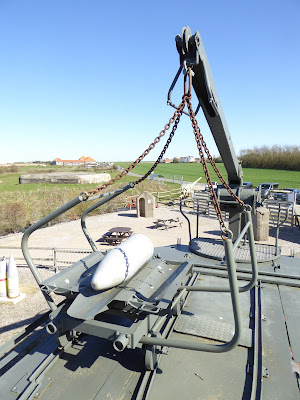 |
| Krupp K5 280mm Rail Gun |
Following the fall of France in June 1940, the Germans began deploying rail guns to the Pas de Calias to support Operation Sea Lion, the invasion of Britain. In addition permanent coastal batteries would be built between Calais and Boulogne to control the English Channel.
 |
| English Channel Gun Batteries |
Normally only one gun would be firing, the other undergoing maintenance.
Calais Grables (2x Guns)
Sangatte-Cement Factory (2x Guns)
Les Alleux (2x Guns)
Hydrequent-Le Carre de Marabee (1x Guns)
Wimereux-Les Oiles (2x Guns)
 |
| Pas De Calais - German Rail Gun Locations. |
 |
| Krupp K5 Railgun emerging from Dombunker |
 |
| Krupp K5 280mm Rail Gun Atlantic Wall Museum Audinghem |
The K5 had a range 64 km (40 miles) firing a 255 kg (562 pounds) high explosive shell.
The time taken to prepare for firing and the low rate of fire (15 rounds per hour) limited the guns to land based targets. Dover and the South Coast were targeted.
 |
| Krupp K5 280mm Rail Gun Firing on Dover |
Krupp K5 280mm Rail Gun
The guns were moved to and from the firing position by a WR360C14 diesel shunter locomotive.
 |
| Krupp K5 280mm Rail Gun Moving using WR360C14 diesel shunter locomotive |
 |
| Krupp K5 280mm Rail Gun Ammunition Hoist |
 |
| Krupp K5 280mm Rail Gun Cartridges being hoisted onto the gun |
 |
| Krupp K5 280mm Rail Gun Atlantic Wall Museum Audinghem Ammunition and rear of gun |
 |
| Krupp K5 Atlantic Wall Museum Audinghem Shell hoisted on to ammunition trolley |
 |
| Krupp K5 Atlantic Wall Museum Audinghem Ammunition loading trolley |
 |
| Krupp K5 280mm Rail Gun Cartridges and Shells |
The ammunition trolley moved along rails on the loading platform to position the shell onto the loading tray. The shell and then the cartridges would be loaded into the chamber and the breach closed.
 |
| Krupp K5 280mm Rail Gun Loading platform |
 |
| Krupp K5 Atlantic Wall Museum Audinghem Shell on loading tray |
 |
| Krupp K5 280mm Rail Gun Ready to fire |
 |
| Krupp K5 280mm Rail Gun Gun being fired |
 |
| Krupp K5 280mm Rail Gun Fire ! |
 |
| Krupp K5 280mm Rail Gun Schuss über ...Shot Over |
 |
| Krupp K5 280mm Rail Gun Schuss über ...Shot Over |
 |
| Krupp K5 280mm Rail Gun Post firing |
 |
| Krupp K5 280mm Rail Gun |
Krupp K5 Leopold
 |
| Krupp K5 Leopold Atlantic Wall Museum Audinghem |
 |
| Krupp K5 Leopold Atlantic Wall Museum Audinghem |
Two Krupp K5s were sent to Italy to target the Allied bridgehead at Anzio. The guns were nicknamed Leopold and Robert by the German Gunners, to the Allied soldiers under their distinctive fire, they were termed Anzio Annie and Anzio Express. The two guns were abandoned when the Allied forces broke out of the Anzio Beachhead.
Leopold has been restored and located at the Atlantic Wall Museum, Audinghem in the Pas de Calais.






























